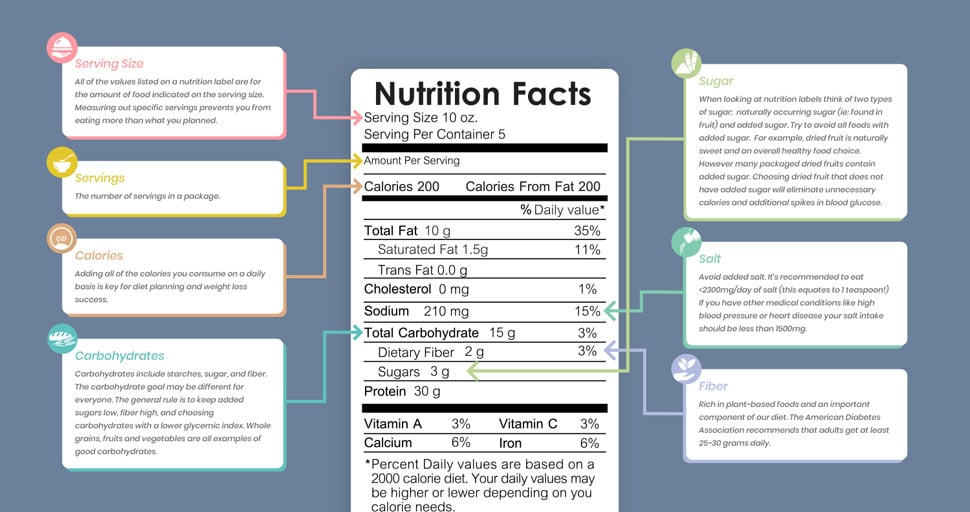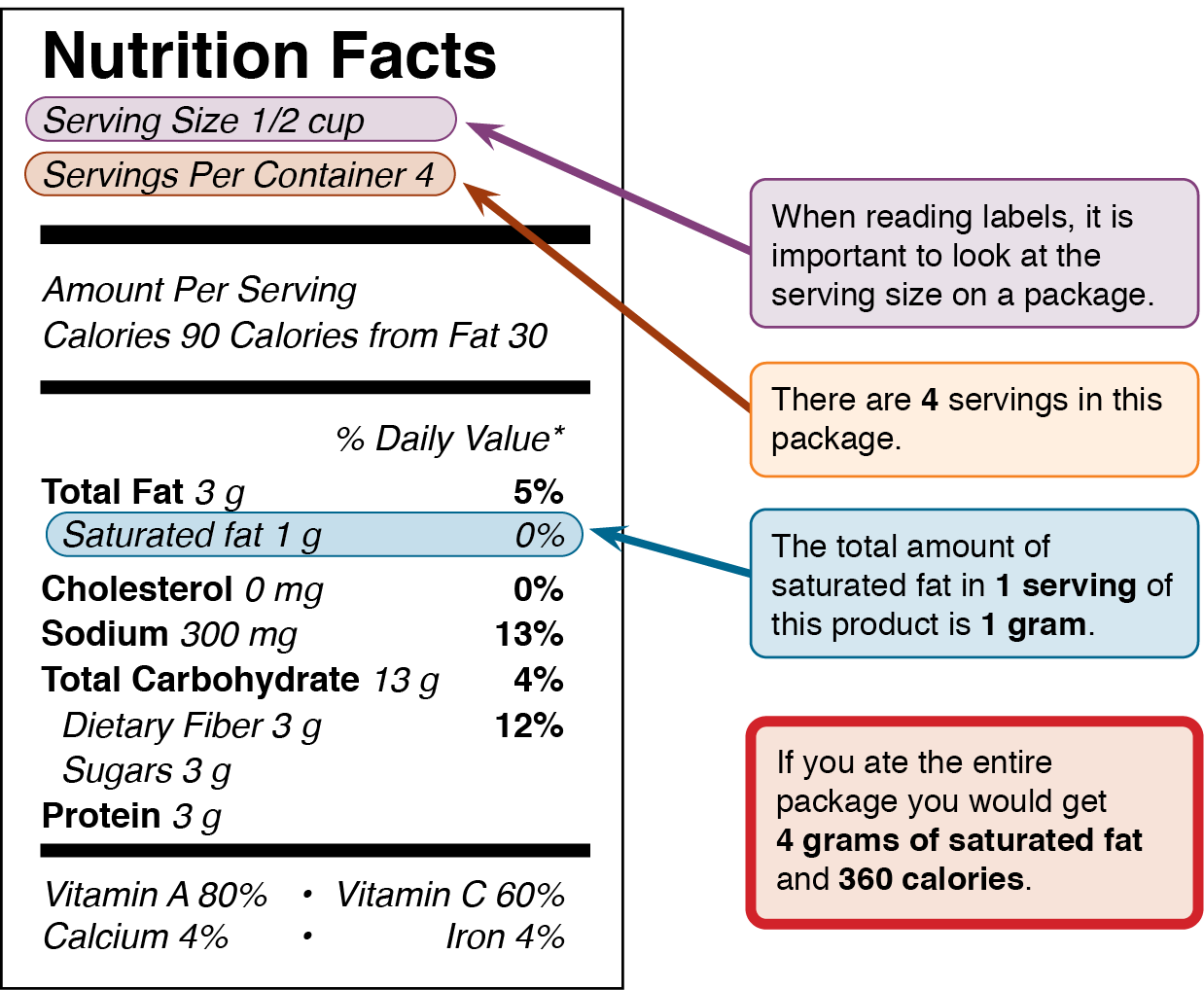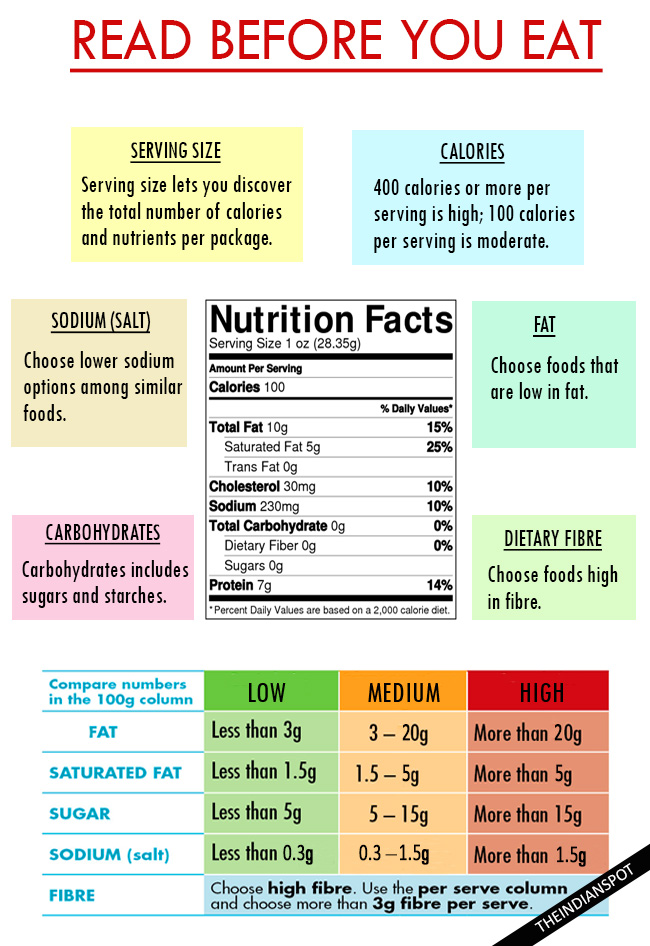38 reading calories on food labels
How to Read Carbohydrates on Food Labels - GlycoLeap When learning how to read carbohydrates on food labels, always remember that 1 serving of carbohydrate is equal to 15 g of carbohydrates. If you want to have a snack, it is recommended to eat no more than 1 to 2 servings of carbohydrates in one sitting. That would be around 15 to 30 g of carbohydrates. Snack = 15 - 30 g of carbohydrate kidshealth.org › en › kidsLearning About Calories (for Kids) - Nemours KidsHealth Most foods and drinks contain calories. Some foods, such as lettuce, contain few calories (1 cup of shredded lettuce has less than 10 calories). Other foods, like peanuts, contain a lot of calories (½ cup of peanuts has over 400 calories). Some people watch their calories if they are trying to lose weight.
Understanding Food Nutrition Labels | American Heart Association 1 - Start with the serving information at the top. This will tell you the size of a single serving and the total number of servings per container (package). 2 - Next, check total calories per serving and container. Pay attention to the calories per serving and how many calories you're really consuming if you eat the whole package.

Reading calories on food labels
How to Read a Nutrition Facts Label - The Family Meal Project The nutrition terms on the label are there to tell you more about some of the nutrients in the food item you are looking at. Calorie Free - less than 5 calories per serving. Low Calorie - 40 calories or less per serving. Fat Free/Sugar Free - less than 1/2 gram of fat or sugar per serving. Low Fat - 3 grams or less of fat per serving. › food › nutritionThe Basics of the Nutrition Facts Label Step 4: Check Out the Nutrition Terms. Low calorie: 40 calories or less per serving. Low cholesterol: 20 milligrams or less and 2 grams or less of saturated fat per serving. Reduced: At least 25% less of the specified nutrient or calories than the usual product. Good source of: Provides at least 10 to 19% of the Daily Value of a particular ... Reading Nutrition Facts Labels - University of Arizona If you eat both servings then you'll actually eat 500 calories. Look at the percent daily value. As a guideline, a % daily value about 20% is high and below 5% is considered low. So this product is high is Calcium and Sodium, but low in Iron, Fiber and Vitamins A and C. Look out for saturated fat, trans fat, sodium and cholesterol.
Reading calories on food labels. 5 tips for decoding food labels - Harvard Health Here are 5 ways to make food labels work for you: Size matters. Serving size is always the first item on the label. All other information is based on that serving size. The servings per container tell you know how many portions are in the whole box, package, or can. Beware: many packages contain more than one serving. Reading Food Labels (for Parents) - Humana - Ohio The number of calories that's listed on the food label indicates how many calories are in one serving. Percent Daily Values Percent daily value is most useful for seeing whether a food is high or low in nutrients: A food with 5% or less of a nutrient is low in that nutrient. A food with 10%-19% of a nutrient is a good source of that nutrient. Learning To Read Labels :: Diabetes Education Online When you read food labels, the grams of sugar are already included in the total carbohydrate amount, so you do not need to count this sugar amount separately. The grams of sugar listed include both natural sugars, from fruit or milk, and added sugars. On a nutrition food label, the total carbohydrate includes the sugar. Some Nutrition Facts ... › en › healthy-livingUnderstanding Ingredients on Food Labels | American Heart ... Mar 06, 2017 · Food labels are an important source of information about calories and the nutritional value of the foods you eat, a crucial tool in building a heart-healthy diet. The Nutrition Facts information is always displayed in the same orderly fashion and helps you understand how much of certain nutrients that you need to limit are contained in the ...
Reading food labels: Tips if you have diabetes - Mayo Clinic Sugar-free foods may play a role in your diabetes diet, but remember that it's equally important to consider carbohydrates as well. A sugar-free label means that one serving has less than 0.5 grams of sugar. When you're choosing between standard products and their sugar-free counterparts, compare the food labels. Reading Food Labels - Food Smart Colorado On average, people need about 2,000 calories a day. Daily Value is the amount of a nutrient you should get each day. The % Daily Values tell you what percent of this daily amount is in one serving. 5% Daily Value or less means that a food is a low source of a nutrient. 20% Daily Value or more means that a food is a high source of a nutrient. How to Read Nutrition Facts Label - Food Network Take that 1600 and multiply it by 0.30 (based on our goal of getting 30% of our calories from fat). You'll get 480 calories. Then, to figure out the grams of fat you want to aim for each day,... Food Labels 101: Understanding the Nutrition Facts Label Nutrition labels are based on a daily 2,000 calorie diet. Depending on your age, gender and activity level, you may need to consume more or less than 2,000 calories per day, so keep this in mind when viewing each label. Now let's take a look at the parts of the nutrition facts label and break it all down. Anatomy of a Nutrition Facts Label
How to Understand and Use the Nutrition Facts Label | FDA That is two times the calories and nutrients shown in the sample label, so you would need to double the nutrient and calorie amounts, as well as the %DVs, to see what you are getting in two... This Is How to Read a Nutrition Facts Label on the Keto Diet This act mandated that, with a few exceptions, all packaged foods needed nutrition labels — thus creating the black-and-white labels we see on packaged foods today. The nutrients that required labeling included: Calories Calories from fat Total fat Saturated fat Cholesterol Sodium Total Carbohydrate Dietary fiber Sugars Protein Vitamin A Vitamin C › media › 131162Quick Tips for Reading the Nutrition Facts Label Consider the calories. 2,000 calories a day is used as a general guide for nutrition advice. Your calorie needs may be higher or lower and vary depending on your age, sex, and physical activity level. Food Labels | CDC Check the Serving size first. All the numbers on this label are for a 2/3-cup serving. This package has 8 servings. If you eat the whole thing, you are eating 8 times the amount of calories, carbs, fat, etc., shown on the label. Total Carbohydrate shows you types of carbs in the food, including sugar and fiber.
› health › how-read-food-andHow To Read Food and Beverage Labels | National Institute on ... Feb 24, 2022 · Although frozen and canned fruits and vegetables have food labels, fresh varieties often do not. You can find nutrition information for fresh vegetables and fruits on the USDA website . Or you can call the U.S. Department of Agriculture’s Food and Nutrition Information Center at 301-504-5414.
Reading and Understanding Food Labels and Nutrition Info - Beaumont Many fresh meats, poultry and fish do not have a nutrition facts label. The average cholesterol per ounce of an animal product is 25 mg. Percent of calories from fat Divide the calories from fat by the total calories. Keep in mind not every food you eat needs to contain less than 30 percent of the calories from fat.
Reading Food Labels: "Calories From Fat" | livestrong The term "calories from fat" refers to the percentage of calories in a serving of food that come from fat rather than from carbohydrates or protein. This figure is listed on nutrition labels for most foods. This amazing kale pesto is only 210 calories and anti-oxidant rich! The percentage of calories a person gets from fat versus carbohydrates ...
› medialibraries › urmcmediaA Guide to Reading Food Labels - University of Rochester Feb 27, 2013 · of calories from fat. You should limit the number of calories from fat to 20-35% of your total daily calories. In the sample label, there are 250 calories in one serving and 110 calories from fat. This means almost 50% of the calories in a single serving of this food come from fat. Due to its high fat content, this food is not a healthy choice.
How To Read Food Labels - 10 Tips | Pritikin Program For Eating Right It's on the Nutrition Facts label. Unfortunately, it doesn't tell you "percent of calories from fat," which is how all health guidelines direct us to limit fat. You've got to do a little math. Divide the number of calories from fat by the total calories. (If the serving's 150 calories, 50 of which are fat, your product is 33% calories from fat.).
How to Read Nutrition Facts | Food Labels Made Easy - YouTube To support our channel and level up your health, check out:Our Fast Weight Loss Course: B...
How to Read Nutrition Labels - Verywell Fit The column on the right side of the nutrition label has numbers displayed in percentages. The numbers listed under "% Daily Value" tell you how much a particular nutrient contributes to your total daily diet if you consume 2,000 calories per day. If you consume more or less than 2,000 calories per day, these figures will not be accurate for you.
How Do They Calculate Calories on Food Labels? It's important to recognize that 4-9-4 is an average, and not an exact amount. For example, 1 gram of fat in one food may yield 8.34 calories while 1 gram of fat from another food yields 9.7 calories. The same thing happens with carbohydrate and protein: the 4-9-4 is an average, not an exact amount.
PDF How to Read the Food Label - Risk Services This is the number of calories you'll eat in one serving of a food. Calories needed each day depends on your age, sex, height, weight, and amount of physical activity. Estimates range from 1,600 to 2,400 calories for women and 2,000 to 3,000 calories for men. If you're trying to lose weight, avoid or limit high-calorie foods.






Post a Comment for "38 reading calories on food labels"